Robots, coral larvae... the ambitious plan to reseed the Great Barrier Reef
The Great Barrier Reef has taken a battering. Now scientists have come up with a radical plan to reseed it.
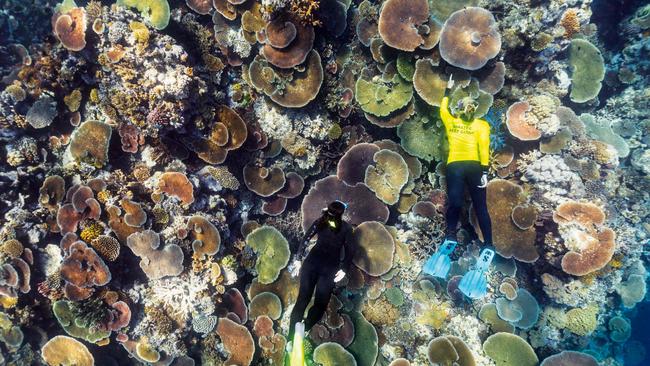
Back in 1981 – when Malcolm Fraser was prime minister and Joh Bjelke-Petersen was king of Queensland – Peter Harrison was at Townsville’s James Cook University studying marine biology. He was madly in love – about to marry his college sweetheart, Barbara, a chemist – and on the verge of making one of the great discoveries in natural history. Mating was very much at the forefront of the young scientist’s mind, particularly how corals got it on.
Harrison grew up on Sydney’s northern beaches and became fascinated with the underwater world while snorkelling at Pittwater and observing fish in the lush sea grasses. It inspired him to study marine biology. At that time at JCU – and every other university where coral was studied – the textbooks declared that all corals brooded; that is, fertilisation occurred within the coral, which continually spat out fully formed coral babies, or larvae. Or so they thought. It was an easy explanation for the incredible fecundity and vibrancy of the world’s coral reefs – that they were continually rejuvenated through this efficient self-fertilising process.
Harrison and his PhD mates were studying brain, plate and branching corals. And what they were observing indicated that many of these corals reproduced by spawning – a process of releasing eggs and sperm into the water in a crapshoot of mass mating. He and his coral-geek mates were living in a share house in Townsville at the time and decided to test out their theories. And so, with borrowed boats and antiquated diving equipment, they set off to explore the magnificent reefs of Magnetic Island, 13km off Townsville, diving by torchlight at night.
What they observed one night after a full moon in October 1981 blew their minds. They watched on in wonder at the incredible underwater fireworks as the corals pumped the ocean with billions of sperm and eggs. They swam by torchlight as the water turned milky white. They were coated with a sticky, smelly coral jizz that got in their hair, ears and mouths – the first time it had ever been observed, or tasted, by science.
It would lead to the discovery that most corals around the world reproduce in this manner, like grasses releasing pollen to the vagaries of the wind. It would uncover the greatest mating event in all of nature – the mass coral spawning. On a warm night in October or November after a full moon, trillions of coral along the 2300km stretch of the outer Great Barrier Reef partake in a massive and co-ordinated frenzy, as if all the world’s schoolies had gathered in Queensland at once.
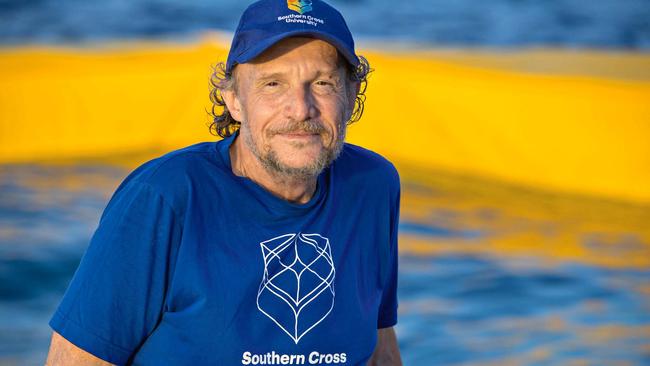
It would turn the study of coral on its head and establish JCU as one of the leading coral research institutes in the world. It would launch the students’ scientific careers and they would collectively win the coveted Eureka Prize for science. Peter Harrison would be the lead author of a paper, Mass Spawning in Tropical Reef Corals, published in the prestigious journal Science in 1984 – it was like winning an Oscar for his very first flick. “It’s been all downhill since then,” he jokes of his academic publishing in the years since. But he could also be talking about the health of the reef itself, which has been on the slide since those heady days of the early ’80s.
In October, Professor Peter Harrison, now head of the Marine Ecology Research Centre at Southern Cross University, went back to the reefs off Magnetic Island where he made his momentous discovery 38 years ago. “I had put literally hundreds of little tags on the coral so that I could follow its progress over time,” he tells me. “Back in the 1980s there were many, many thousands of corals on those reefs.” It was pristine, incredibly beautiful and diverse; an underwater wonderland. “Now, most of that area is covered in macro algae,” like a brown sludge. “Most of the corals there are now dead.”
But Harrison is a hopeful man. He is now using his old discovery of coral spawning in a futuristic program using underwater robots, in the hope that he can buy the reef some time. He’s harvesting some of the coral larvae that would otherwise float off and perish, and putting it to good use. If the world can somehow arrest rising water temperatures due to climate change, Harrison reckons he may have hit upon an idea to provide the seed stock to repopulate the reef. The Great Barrier Reef, he says, is “certainly not dead” but it has been significantly damaged by mass bleaching events and is under incredible pressure. “If we wait for 30 years to see a reversal of climate change, most of our coral could be dead.” He’s constructing an ark that he hopes may withstand the onslaught.
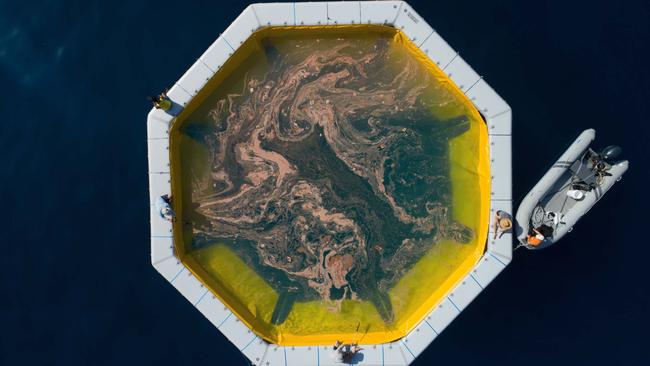
In 1897 in London, Mark Twain was supposed tohave made his famous quip that reports of his death had been exaggerated. But then, 13 years later, he was undoubtedly dead. Likewise, the Great Barrier Reef has often been written off when it is very much alive. It’s vast, the size of Italy, with thousands of reefs hugging 2300km of the Queensland Coast. While significant sections are ailing, many of the reefs are in good health – but that doesn’t mean we won’t be reading a genuine and solemn obituary as temperatures and ocean acidification continue to rise.
A small rise in temperature can have a devastating effect. As a scientist explained to me, if your kid has a temperature of 37.5°C, the treatment is a nap and a couple of Panadols. If it gets to 39 degrees, you’re in the car speeding to emergency. “The reef has a fever and the thermometer is still heading in the wrong direction,” she says.
The Great Barrier Reef is under constant attack from cyclones, predators such as crown-of-thorns starfish, agricultural runoff and mass bleaching caused by a spike in water temperatures. It can and does recover from these events. However, if cyclones become more severe and regular and the bleaching more frequent, the reef will have less time to rejuvenate between each assault.
This combination of factors is already having a devastating effect on the overall health of the reef. In 2012, the Australian Institute of Marine Science (AIMS), which has been conducting extensive monitoring of the reef for decades, issued a press release headed The Great Barrier Reef has lost half its coral in the last 27 years. The news since has been grim. “From 2012 to 2016 there was a period of strong Great Barrier Reef-wide recovery, but then back-to-back bleaching in 2016 and 2017, numerous tropical cyclones and crown-of-thorns starfish outbreaks have again reduced coral cover across the Great Barrier Reef,” Dr Mike Emslie, from AIMS, tells me in an email. Coral cover in 2019 is at the third lowest level recorded in 34 years of monitoring. “Great Barrier Reef-wide coral cover in 2019 is 56 per cent of what it was at the start of the Long Term Monitoring Program in 1986. In the northern region it is 59 per cent of initial levels; the central GBR is 54 per cent and southern GBR is 69 per cent.”
Just recently, a report by the federal and Queensland governments to UNESCO admitted that the prospects for the Great Barrier Reef are gloomy. “Mass coral bleaching events in 2016 and 2017, six tropical cyclones, flooding, and a coral- eating crown-of-thorns starfish outbreak have impacted the Outstanding Universal Value of the (reef) since the last report in 2015,” it says. “The Great Barrier Reef Marine Park Authority found that the long-term outlook for the reef’s ecosystem has deteriorated from poor to very poor… Concerted global action to limit global warming is needed to turn around the deteriorating outlook for the Great Barrier Reef – and all other coral reefs.” But what can be done?
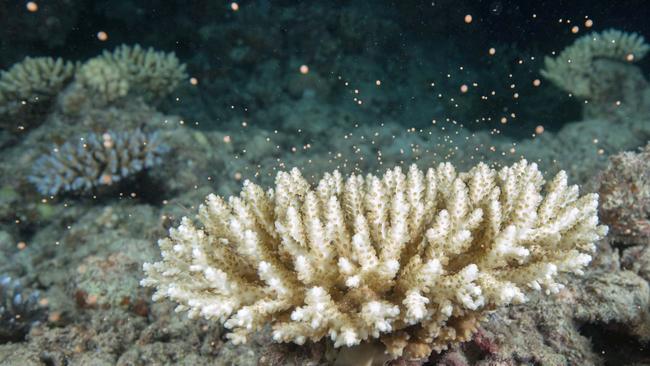
A couple of weeks ago, at the invitation of Tourism Queensland and the conservation group Citizens of the Great Barrier Reef, The Weekend Australian Magazine and other journalists flew to Cairns to observe the annual mass coral spawning and to look at a number of coral restoration projects in which tourism operators have partnered with scientists. With 64,000 people directly employed in reef tourism and two million tourists contributing $6.4 billion each year, Queensland has a lot riding on its survival.
One night, we chug out of Cairns on a dive boat to Moore Reef with 50-odd eager tourists in the hope of catching the great coral spawning. Along the way I chat with Wendy Morris, the chair of Tourism Tropical North Queensland. Her family were farmers who moved into tourism and rode the massive tourism wave brought about by cheap flights – at one stage they owned more than 1000 hotel rooms around Port Douglas. She’s also a qualified marine biologist and first started diving on the reef in 1974 – it is her great love. For her, this is a delicate dance, conveying the need for action without frightening off tourists.
“I’ve seen multiple cyclones and storms and the crown-of-thorns starfish, but by far the most devastating thing was the bleachings of 2016 and 2017,” she says. But, Morris insists, the damage was isolated. “Most of the tourism sites were relatively unaffected. I liken the reef to Italy; it’s that diverse. So you have the equivalent of mountains, coastline and hundreds of villages and all of it is different.” There are “some incredible bright spots” that should give us hope, she adds. “I have certainly seen places that are as spectacular, or more spectacular than they’ve ever been.”
The Great Barrier Reef is the best-managed reef system in the world, Morris says, and the best thing that can happen is for people to visit its still magnificent parts. “If you see it for yourself and you’re inspired, you take it home in your heart – it’s visceral. The most important thing people can do for the reef is to visit it. You can read every UNESCO report, every climate change report, but nothing is like seeing the reef in all its glory. It empowers everyone who sees it to do something about climate change.”
The talk of reef death, however, has definitely had a negative impact. “We monitor how much interest there is in the Great Barrier Reef – looking at online conversations – and it’s been gradually falling since 2017,” Morris says. “To me, that’s the greatest tragedy, because the reef changed my life when I was nine years old and I was lucky enough to put my head underwater and it’s never been the same for me since.”
After an hour or so, we reach Moore Reef – 50km off the coast of Cairns, it is to Queensland what the Mona Lisa is to Paris. A good percentage of people who visit the reef come to the various pontoons tethered to this 2600ha patch. It’s a microcosm of what’s happening all over the Great Barrier Reef and it alone is worth many hundreds of millions of dollars to the Queensland economy.
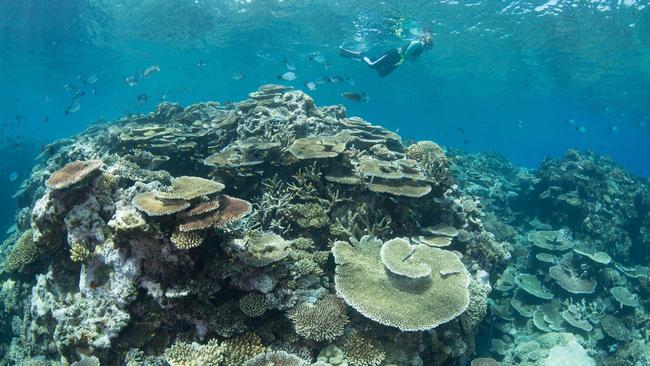
We put on our diving gear and plunge into the darkened ocean with great expectations. We swim past a magnificent wall of coral that has recovered 70 per cent of its cover after being reduced to just five per cent by Cylone Yasi in 2011. It somehow recovered, too, from the bleaching events of 2016 and 2017. And then, just 10m away, up on a shallow reef shelf, we see devastation caused by the twin bleachings – it’s like a poisoned forest. It wiped out 95 per cent of the coral cover but you can see the baby corals regenerating among the carnage. Another hit would be catastrophic. We see a few sharks, some magnificent fish, and some evidence that the spawning is about to begin, but alas, no money shot. We miss the action, and in the morning are told that the spawning occurred a couple of hours after our dive. It was magnificent, apparently, but we missed the party.
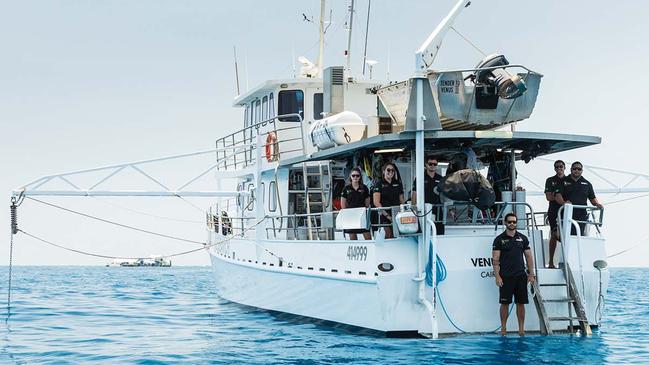
Over the following days we get to observe a number of restoration projects. At Saxon Reef, dive operators are working on a coral gardening project in which broken pieces of coral are collected and attached to aluminium frames suspended in the water. When the coral reaches a certain size they are transplanted to form new reefs.
Back on Moore Reef, we meet scientists working on a reef stabilisation project using steel frames, like those of an umbrella. Placed across a damaged reef, these frames attract corals and allow the reef to reform after cyclones. The project has been trialled in Mexico and Indonesia, where 19,000 such frames were used to successfully rehabilitate four hectares of damaged reef.
Scientists from AIMS are working on an early detection system for outbreaks of crown-of-thorns starfish using DNA monitoring. The problem with the traditional detection method – divers spotting them on the ocean floor – is that by the time they’ve reached that stage it’s often too late to halt an advancing plague. Jason Doyle, from AIMS, says they now have hundreds of test sites along the reef. Water samples are collected regularly (often by tourism operators) and analysed for any increase in larval levels of starfish. “We call it the dipstick test,” says Doyle. “It’s a bit like pregnancy testing.” If elevated levels of starfish DNA are detected, eradication can take place before they take hold.
“Never before have we seen all the players working together in such a concerted manner,” says Morris. “The tourism operators, the dive masters, the scientists, everyone is trying to do their best for the reef.” This co-operation is evident in the most ambitious project of all: Professor Harrison’s plan to use robots to plant coral.
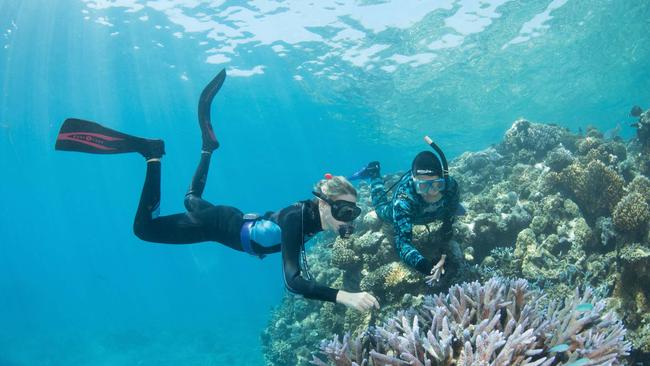
It is on a platform above Moore Reef that I catch up with Harrison. He’s wearing a wetsuit and water drips from his hair and scruffy beard. He has the craggy features of a man who’s spent decades in the tropical sun. “This is an enormous challenge,” he says of his restoration project. “But we’ve got to give it a try, we’ve got to do something.” He likens his project to buying up tracts of land and fencing it off from feral animals to save native marsupials, reptiles and birds while we figure out how to deal more broadly with the scourge. “I’m trying to buy time,” he says.
Harrison’s idea was born back in 1981, when he first witnessed mass coral spawning off Magnetic Island. What if you could capture some of those billions of coral larvae that would otherwise float away and die, and plant them on the reef? Then came advances in technology. What if those billions of captured coral larvae could be put into robots that could glide across the ocean floor, like a tractor towing a seeder across a wheat field, planting new and vibrant reefs? He’s had great success in the Philippines with this method, restoring hectares of coral reefs degraded by environment changes and decimated by dynamite fishing – explosives thrown into the water to stun fish, smashing the delicate reefs in the process. He’s been working there since 2012 and corals he seeded “are now the size of dinner plates”.
Now he’s come to Moore Reef because of its incredible resilience. “It somehow survived the mass coral bleachings of 2016 and 2017 – it is likely that those corals that survived have a higher tolerance to high temperatures and that is why we are using them as the brood stock.” He’s partnered with scientists from James Cook University, the University of Technology Sydney, robotics expert Professor Matt Dunbabin from Queensland University of Technology, and tourism operators Reef Magic and Aroona Boat Charters.
In a nutshell, the project works like this: when the coral spawns, divers swim out with spawn catchers – fine mesh nets. “All these millions of polyps float to the surface and we capture a very small percentage of them, less than 0.01 per cent, and we contain it in floating pools so that it doesn’t drift away,” Harrison says. And then they supercharge them. Corals have a symbiotic relationship with algae – which provide food and the vivid colouring – and the scientists add this algae to their captured larvae “so that when they settle on the reef they are more likely to have a chance of acquiring energy quickly to survive”. It’s been likened to giving the baby coral a battery pack for their early survival.
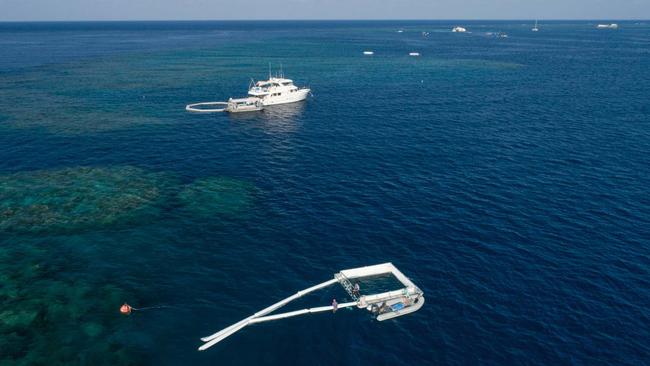
He points to the six larval pools floating above reefs around us where his baby corals are growing. “My guess is that we probably have somewhere near 100 million coral larvae there right now, which is way beyond what anyone has done so far.” After a week, these coral larvae will be settled on a section of damaged reef. It can be done manually, using a fine mesh that sits across the top of the reef, allowing the larvae to settle and take hold. Or it can be done using robots known as a LarvalBots, which are loaded with coral larvae and cruise just above the reef, spitting out the baby coral onto the targeted and damaged areas.
Dunbabin, the robot’s inventor, says that in a trial conducted in the Philippines this year a LarvalBot was able to seed an area of three hectares in just six hours. Wherever it’s been trialled it’s been phenomenally successful and it has created immense interest around the world. Harrison says: “Based on the results we got on the reef this year I am confident that if we had the resources and the engineering collaboration we could increase this from hectares to thousands of hectares within next three to five years.”
When he first proposed his idea of coral restoration, it was met with a large dollop of scepticism from his colleagues. “But many people now realise that we need to take action now,” Harrison says. “We don’t believe there will be sufficiently fast action on climate change to reverse the trends we are seeing, so we need to start rescuing these coral communities that we have left.
“We’ve got to live in hope,” he adds. “We’ve got to be passionate and we’ve got to get out of bed each morning and fight harder… we can’t just let the reef wither and die under our watch.”


To join the conversation, please log in. Don't have an account? Register
Join the conversation, you are commenting as Logout